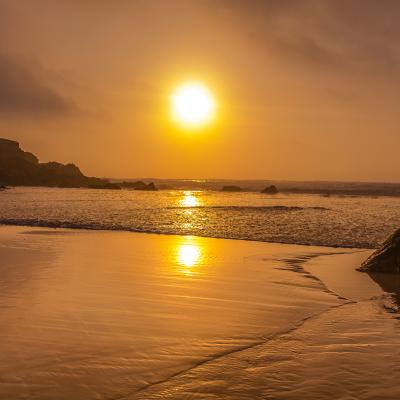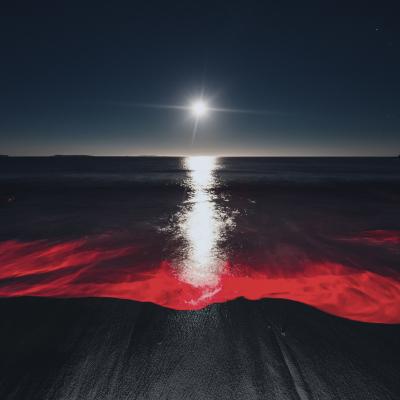Anúncios
Ocean tides are a natural phenomenon resulting from the gravitational interaction between the Earth, the Moon, and the Sun. This phenomenon causes the rise and fall of sea levels, known as tides, which occur cyclically throughout the day. Understanding this process is essential as it impacts everything from maritime activities to environmental issues.
The Moon is the celestial body with the greatest influence on tides due to its proximity to Earth. However, the Sun also plays an important role, although its gravitational force is weaker. Studying these influences and their variations over time is crucial for various fields of knowledge, including marine biology, navigation, and coastal management.
Anúncios

The Moon’s Role in Ocean Tides
The Moon is the primary responsible for the formation of tides on Earth. Its gravitational pull draws water from the oceans towards it, creating a high tide. This happens in two regions of the Earth at the same time: one where the Moon is closest and the other on the opposite side, due to the centrifugal force of the orbital movement.
The rotation of the Earth also influences the intensity and frequency of tides. Every 24 hours, the Earth rotates enough for two high tides and two low tides to occur, due to the gravitational action of the Moon and the planet’s rotational movement.
Furthermore, the phases of the Moon, such as the full moon and new moon, intensify or soften the tides. When the Moon, the Sun, and the Earth align, tides tend to be higher, a phenomenon known as the syzygy tide.
The Sun’s Impact on Tides
Although the Sun is much farther from the Earth than the Moon, its gravity also has a significant impact on tides. Its gravitational pull helps increase or decrease the height of tides, but to a lesser extent. During certain periods, the Sun’s effect is more noticeable.
When the Sun and the Moon align, as during the new and full moons, their gravitational forces combine to create extremely high and low tides. This phenomenon is called the syzygy tide, characterized by a more intense variation than regular tides.
On the other hand, when the Moon and the Sun are at right angles to the Earth, their gravitational forces oppose each other, resulting in more moderate tides. This happens during the first and third quarters of the Moon.
How Ocean Tides and Gravitational Influences Work

Ocean tides are a fascinating natural phenomenon that results from the gravitational force of the Moon and the Sun on the Earth’s oceans. This gravitational interaction creates a rhythmic rise and fall of sea levels, known as tides, which can be observed along the world’s coastlines. The Moon, being the closest celestial body to Earth, exerts a significant influence on the tides, while the Sun, despite being much farther away, also plays a crucial role in the tidal cycle. Understanding the mechanics behind these gravitational interactions is essential for several fields, including marine biology, navigation, and environmental science.
The primary force driving ocean tides is the gravitational attraction between the Earth and the Moon. As the Moon orbits the Earth, its gravitational pull causes water to accumulate in the direction of the Moon, creating a high tide. Simultaneously, on the opposite side of the Earth, another high tide occurs due to the centrifugal force created by the Earth-Moon system’s rotation. This results in two high tides and two low tides approximately every 24 hours. The gravitational influence of the Sun, although weaker than that of the Moon, also contributes to the tidal patterns we observe. When the Earth, the Moon, and the Sun align during full and new moons, we experience higher high tides and lower low tides, known as syzygy tides. On the other hand, during the first and third quarters of the lunar cycle, when the Moon and the Sun are at right angles to the Earth, we experience lower high tides and higher low tides, known as quadrature tides.
The interaction of these celestial bodies creates a complex and dynamic tidal system that varies based on geographic location, coastline shape, and local climatic conditions. Tidal intervals can differ significantly from place to place, influenced by factors such as ocean depth, the presence of bays and estuaries, and even human activities. Understanding how ocean tides work is crucial for predicting tidal movements, which have practical applications in fishing, navigation, and coastal management.
Benefits of Understanding Ocean Tides and Gravitational Influences of the Moon and Sun
Gaining a deeper understanding of ocean tides and the gravitational influences of the Moon and the Sun offers numerous advantages across various sectors. For coastal communities, knowledge of tidal patterns is essential for effective coastal resource management and planning. By understanding when high and low tides occur, communities can better prepare for potential flooding, erosion, and other environmental changes. This knowledge is particularly crucial in the face of climate change, where rising sea levels pose significant threats to coastal habitats and human settlements.
In addition to environmental management, understanding ocean tides is vital for navigation and maritime activities. Sailors rely on accurate tidal information to ensure safe passage through coastal waters. Tides can affect the depth of navigable channels, and knowing the timing and magnitude of tides helps prevent groundings and ensures safe vessel operation. Furthermore, the fishing industry benefits from knowledge of tides, as certain fish species are more active during specific tidal phases. Fishermen can optimize their catches by aligning their efforts with the natural rhythms of the tides.
Moreover, studying the gravitational influences of the Moon and the Sun can enhance our understanding of broader astronomical phenomena. The study of tides provides insights into the gravitational interactions between celestial bodies, contributing to our knowledge of orbital mechanics and the dynamics of the Earth-Moon system. This understanding can also inform research in fields like geology, where tidal forces may influence sediment transport and coastal erosion processes.
Finally, a comprehensive understanding of ocean tides and their gravitational influences promotes a greater appreciation for the interconnectedness of natural systems. It highlights the delicate balance between celestial mechanics and terrestrial environments, encouraging a sense of responsibility for our oceans and coasts. As we face growing environmental challenges, recognizing the role of tides in shaping our planet can inspire more sustainable practices and policies aimed at preserving our natural resources for future generations.
How to Observe Ocean Tides and Gravitational Influences of the Moon and Sun
Understanding and observing ocean tides and the gravitational influences of the Moon and the Sun can be a rewarding experience. Here are several ways to engage with this fascinating phenomenon:
Understand the Moon’s gravitational force on the tides: To begin observing ocean tides, it is essential to understand the fundamental role of the Moon’s gravitational force. As the Moon orbits the Earth, its pull creates a rise in the ocean’s surface, leading to high tides. By studying the Moon’s phases and their correlation with tidal patterns, you can gain insights into how lunar cycles influence tide behavior.
Learn about the Sun’s gravitational effect on ocean tides: While the Moon has a more significant impact on tides, the Sun’s gravitational pull also plays a crucial role. Understanding how the Sun’s position relative to the Earth affects tidal patterns can enhance your observations. During the new and full moons, when the Sun and Moon align, their combined gravitational forces lead to more pronounced tidal changes.
Observe tide patterns and marine cycles: One of the best ways to appreciate ocean tides is to observe them in person. Visit coastal areas at different times of the day to witness the movement of tides. Notice how the shoreline changes with each tide cycle and how marine life responds to these fluctuations. Keep a tide chart handy to correlate your observations with the predicted times of tides.
Recognize tide movement: Tides are not just about high and low water levels; they also involve the movement of water in and out of coastal areas. Pay attention to the speed and direction of tidal currents, as they can influence navigation, sediment transport, and the distribution of marine organisms. Understanding this movement will deepen your appreciation for the dynamic nature of ocean environments.
Study the impact of the Moon on tides: The Moon’s gravitational influence is not uniform across the globe. Factors such as geographic location, ocean depth, and coastal topography can affect how tides manifest in different regions. Research how the Moon’s position affects tidal intervals in various locations and consider how local conditions may amplify or diminish the effects of tides.
Explore the Sun’s effects on tidal forces: In addition to the Moon, the position and gravitational pull of the Sun also affect tides. By studying how solar cycles, such as solstices and equinoxes, influence tidal patterns, you can gain a more comprehensive understanding of the forces at play. Observing tidal changes during these solar events can provide fascinating insights into the interconnectedness of celestial mechanics.
In conclusion, observing ocean tides and the gravitational influences of the Moon and the Sun is a rewarding endeavor that deepens our connection with the natural world. By understanding the mechanics behind these phenomena, we can better appreciate the rhythms of our oceans and the forces that shape them.
Did You Enjoy Learning About Ocean Tides and Gravitational Influences of the Moon and Sun?
Learning about ocean tides and the gravitational influences of the Moon and the Sun opens a world of wonders and curiosity. The intricate dance between these celestial bodies and our planet creates a dynamic system that shapes coastlines, influences marine life, and impacts human activities. By exploring these concepts, we gain a deeper appreciation for the forces that govern our natural environment.
As you continue your journey of discovery, consider how knowledge of tides can enhance your understanding of the world around you. Whether you are a coastal resident, a marine enthusiast, or simply a curious learner, the study of ocean tides and their gravitational influences offers endless opportunities for exploration and insight.

Frequently Asked Questions
What are tides?
Tides are the rise and fall of sea levels. They occur because of the gravitational force of the Moon and the Sun.
How does the Moon influence the tides?
The Moon’s gravity pulls water from the sea. This causes the tides to rise. When the Moon is full, the tides are higher.
Does the Sun also affect the tides?
Yes! The Sun has an influence, but it is smaller than the Moon’s. Together, they create high and low tides at different times.
How often do tides occur?
Tides happen twice a day. This is because the Moon and the Sun change position relative to the Earth.
How can I know when there will be a high or low tide?
You can use tide tables. They show the times of high and low tides. This way, you can better plan your activities!
